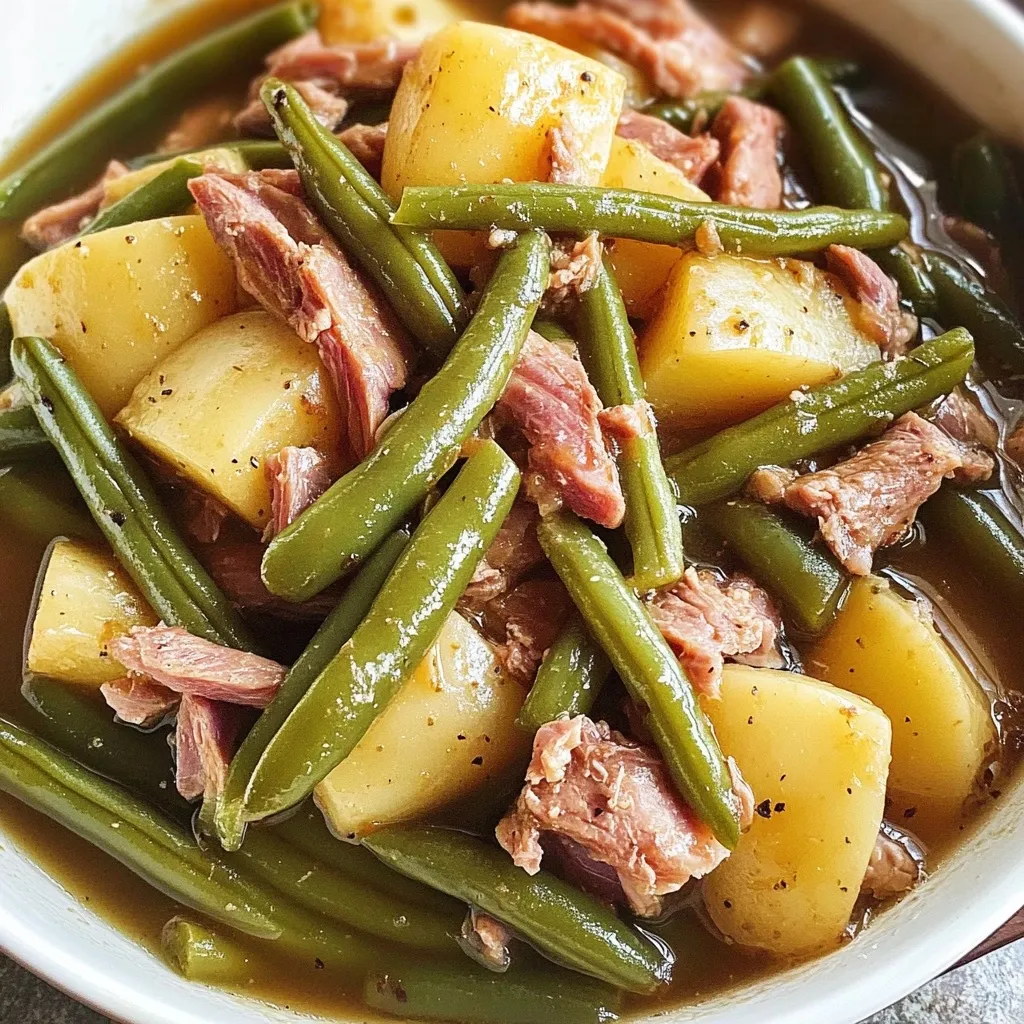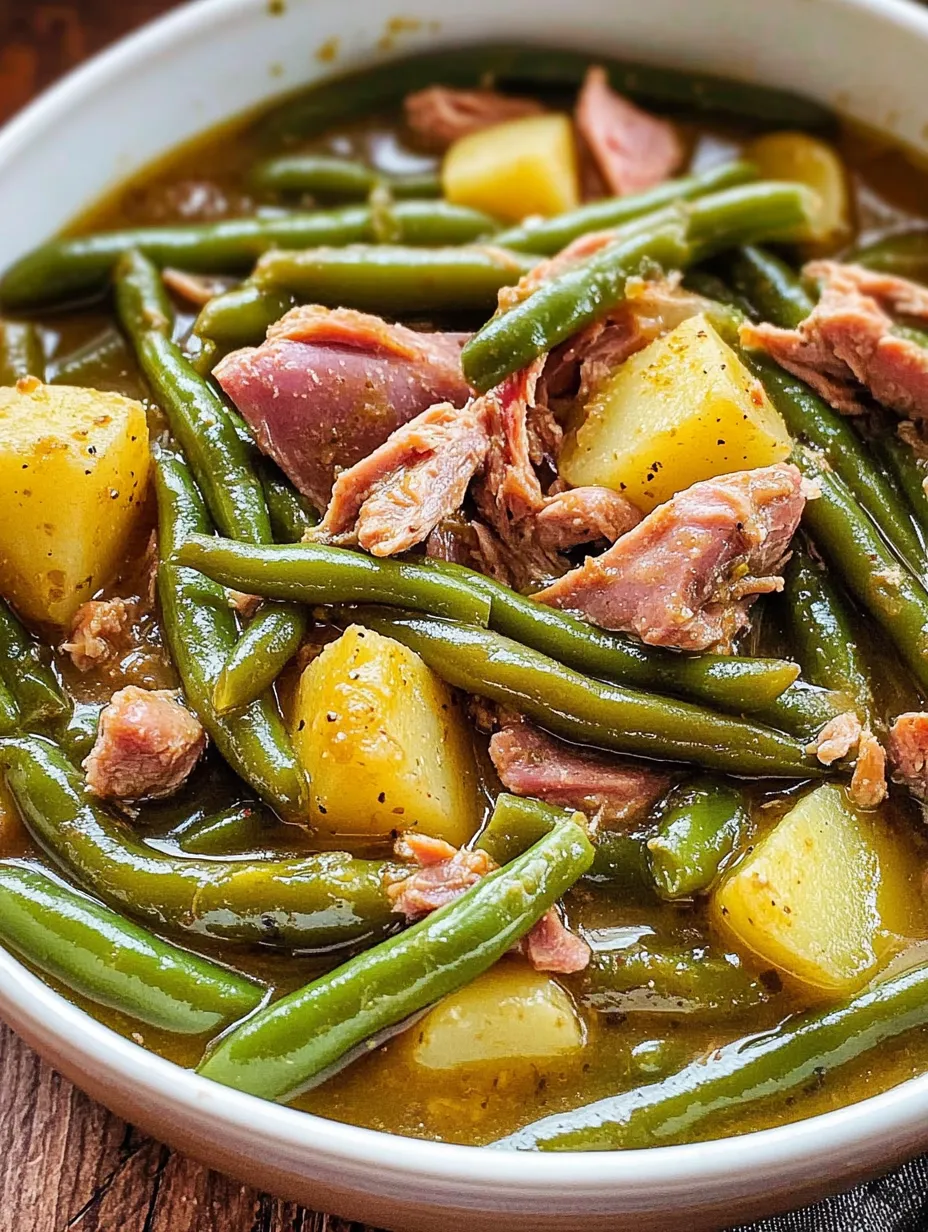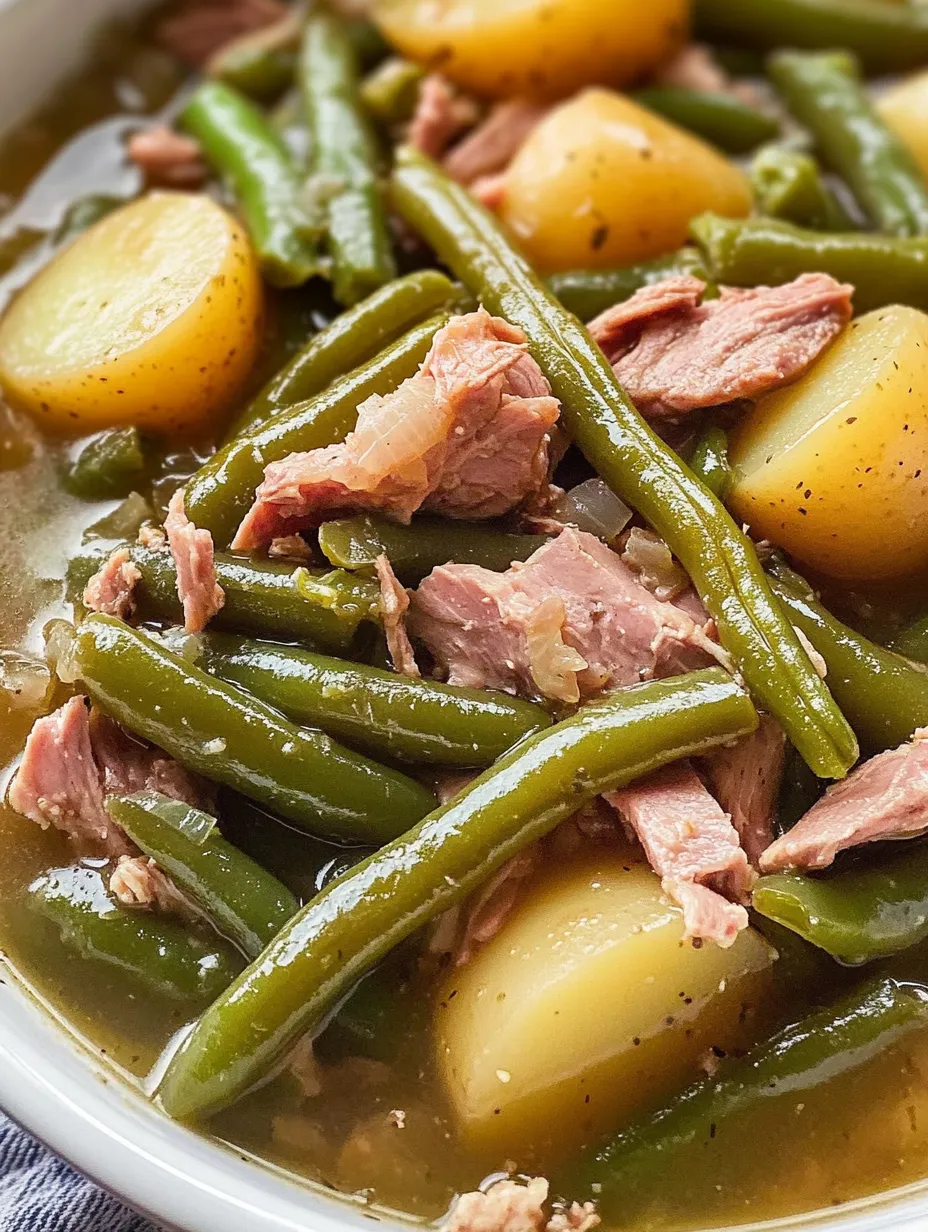 Pin it
Pin it
I learned how to make these Southern-style green beans from my grandmother, who always had a pot simmering on the stove when we'd visit. Unlike those quick-blanched, crisp green beans you might be used to, these are slow-cooked until they're tender and infused with smoky, meaty goodness from turkey necks. The potatoes soak up all that flavor too, making this dish hearty enough to be a meal on its own. Every time I make these, the smell takes me right back to her kitchen in Georgia.
Last Thanksgiving, my city cousin who claims to hate vegetables had three helpings of these beans and asked if he could take some home. When a vegetable-hater asks for seconds (and thirds!), you know you've got something special. Now my family expects these at every holiday gathering.
Key Players
- Smoked turkey necks: give that distinctive smoky flavor without using pork. They're meatier than they look and create an amazing broth.
- Fresh string beans (not canned!): are essential - they hold up to the long cooking time.
- Red potatoes: keep their shape better than russets, which would fall apart.
- Chicken bouillon powder: adds depth that plain salt just can't match.
- Plenty of black pepper: brings everything together with a subtle kick.
I've tried using smoked ham hocks when turkey necks weren't available, and they work great too. But I've found the turkey necks are a bit leaner and many of my friends who don't eat pork appreciate the option. The first time I made these, I skimped on the cooking time thinking I could rush the process, but that extra hour really transforms them from ordinary to extraordinary.
 Pin it
Pin it
Cooking Method
- Broth building:
- Start by filling a large stockpot with water and dropping in those meaty smoked turkey necks. Bring it to a rolling boil, then turn it down to a low boil. This isn't a gentle simmer - you want a little action in the pot, but not a full-on boil. Cover it and let it go for a good two hours. This is where the magic starts happening - those necks release all their smoky goodness into the water, creating a broth that's going to flavor everything else. The house starts smelling amazing about an hour in. Don't rush this step - it's the foundation of the whole dish.
- Flavor boosting:
- After the two hours, check your water level. If it's gotten too low, add just enough to cover those necks again. Now toss in your chopped onion and garlic - I like to chop mine pretty fine so they almost melt into the broth. Add that chicken bouillon powder (I use Knorr, just like my grandma did) and give everything a good stir. Take a little taste of the broth - it should taste rich and savory, slightly salty but not overwhelmingly so. This is where I sometimes add a bit of seasoning salt if it needs it. The broth should taste good enough to drink on its own.
- Bean business:
- Add your quartered red potatoes and those string beans you've prepped (I snap the ends off and break them in half by hand rather than cutting them - old habit from helping grandma). Make sure everything's submerged in that beautiful broth. Cover the pot again and keep it cooking at that low boil. The beans will start off bright green but will gradually take on a deeper, olive color as they cook. That's exactly what you want. They're not going to be crisp - Southern-style beans are all about that tender, silky texture that comes from the long cooking time.
- Patience period:
- Let the beans and potatoes cook for about 45 minutes. I check the potatoes for doneness - you want them quite tender but not falling apart. The beans should be soft enough to cut easily with the side of a fork. This is when I stir in a generous amount of black pepper - it might seem like a lot, but that pepper bite is characteristic of Southern beans. Give everything another taste and adjust your seasonings if needed. Then take the pot off the heat but keep it covered while you deal with the turkey necks.
- Meat matters:
- Fish out those turkey necks and set them aside just until they're cool enough to handle without burning your fingers. Then pull the meat off, discarding the skin and bones. There's more meat on those necks than you might think! Break it into bite-sized pieces and add it back to the pot. Sometimes I find it easier to use my hands for this job rather than trying to do it with utensils - it's a bit messy but more effective. If you're using ham hocks instead, you can either break them up right in the pot with a spoon or pull the meat off and add it back in.
- Serving style:
- Ladle generous portions into bowls, making sure everyone gets some of that flavorful broth along with the beans, potatoes, and meat. In my family, we serve these with cornbread for sopping up the juices, but a chunk of regular bread works too. These beans actually taste even better the next day after the flavors have had more time to meld, so don't worry about leftovers - they won't go to waste!
My first attempt at making these on my own was a disaster - I didn't use enough water, got distracted with a phone call, and came back to a scorched pot with barely any liquid left. Now I set a timer to check the water level every 30 minutes or so during the long simmer. I've also learned that different brands of smoked turkey necks vary in saltiness, so I always taste the broth before adding any additional salt or bouillon.
Perfect Pairings
These green beans are substantial enough to be a meal with just some cornbread on the side, which is how we often ate them growing up. For a traditional Southern meal, serve them alongside fried chicken or smothered pork chops. They're also perfect with baked chicken or turkey any time of year - not just during the holidays. If you're serving them as a side dish at a bigger meal, you might want to strain off some of the broth to make them easier to serve, but don't throw that liquid gold away - it makes an amazing base for soup the next day.
 Pin it
Pin it
Easy Changes
If you're watching sodium, you can rinse the smoked meat before boiling and use low-sodium bouillon. For a spicier version, add a diced jalapeño or a dash of hot sauce. Some people in my family like to add a tablespoon of apple cider vinegar right at the end for a subtle tang that brightens everything up. During the summer when beans are plentiful, I sometimes throw in different varieties - a mix of green and yellow wax beans creates a pretty color contrast while keeping that classic flavor.
I've made these Southern green beans for potlucks, family dinners, and holiday gatherings over the years, and they never fail to get compliments. There's something about that long, slow cooking process that transforms simple ingredients into something truly special. While they might not be the quickest side dish to prepare, they're definitely one of the most satisfying. And that smell that fills the house while they're cooking? Better than any candle you could buy.
Frequently Asked Questions
- → Can I use smoked ham hocks instead of turkey necks?
- Absolutely! Smoked ham hocks work perfectly in this recipe and are traditional in Southern cooking. Use them exactly the same way as the turkey necks.
- → Why are the green beans cooked so long?
- Southern-style green beans are traditionally cooked until very tender, unlike the crisp-tender method of other cuisines. This long cooking allows the beans to absorb all the smoky, meaty flavors from the broth.
- → Can I make this recipe in a slow cooker?
- Yes! Cook the smoked meat with water and seasonings on low for 6-7 hours, then add the vegetables and cook for another 2-3 hours until tender.
- → What can I serve with these Southern green beans?
- These beans pair perfectly with cornbread, fried chicken, meatloaf, or other Southern classics like mac and cheese or black-eyed peas.
- → Can I use canned or frozen green beans?
- Fresh is best for texture, but you can use frozen green beans in a pinch. If using frozen, reduce cooking time to about 30 minutes. Canned beans aren't recommended as they'll become too mushy.
- → How do I store leftovers?
- Store leftover green beans in their broth in an airtight container in the refrigerator for up to 4 days. They often taste even better the next day as the flavors continue to develop.
